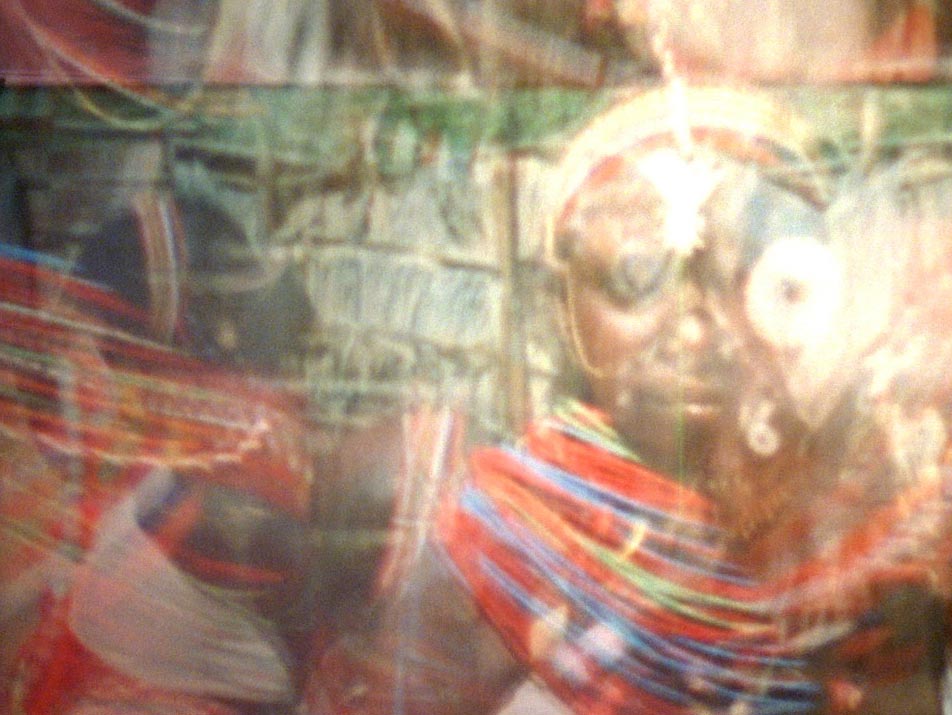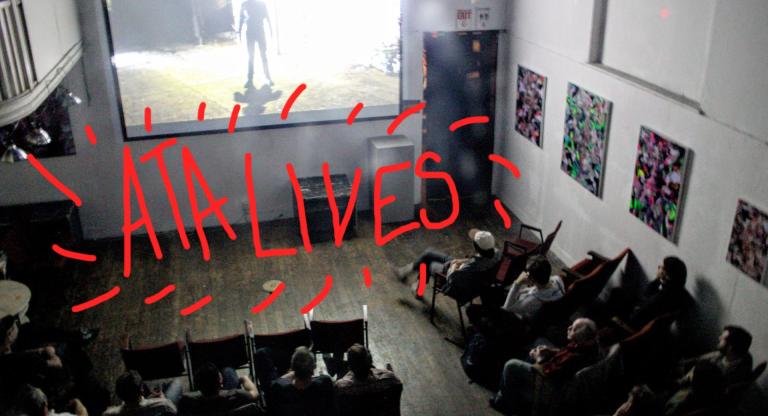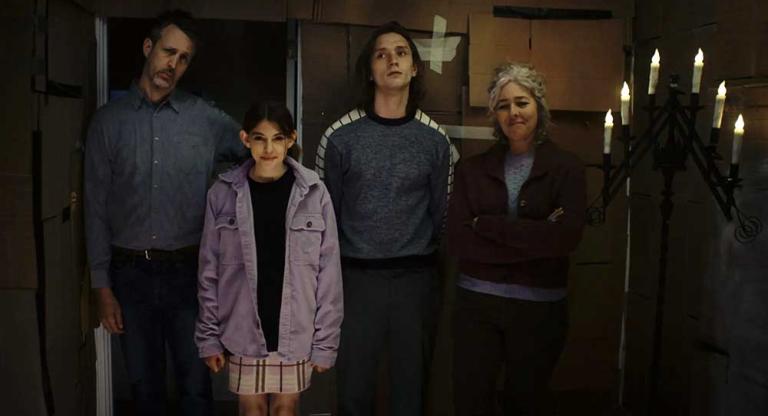Screen Slate is pleased to publish these extended program notes on the occasion of “Colonial Stutters,” screening tonight at Light Industry.
Moune Ô, Maxime Jean-Baptiste, 2022, digital projection, 16 mins
Halimuhfack, Christopher Harris, 2016, digital projection, 4 mins
Missing Time, Morgan Quaintance, 2019, digital projection, 14 mins
Towards a Black Testimony, Languid Hands, (2019–), digital projection, 36 mins
The records of empire are a smooth surface of forgetting. Nothing less than a totalizing amnesia could transform brutal histories of conquest, genocide, and exploitation into tidy stories of progress, development, and universal freedom. The technologies of cinema have served this purpose well, imposing and stabilizing dominant narratives in the service of maintaining the dominant orders of power.
Yet cinema also holds the possibility of counter-narratives—works that steal away from the official records to show what they hid or were never able to hold. Such experiments have acted as the glitch, the rupture, the stutter in the polished continuity of the stories capitalism, colonialism, and imperialism tell about themselves.
This quartet of films reveals the improvised interruptions of liberation. Languid Hands (Rabz Lansiquot and Imani Robinson), Maxime Jean-Baptiste, Morgan Quaintance, and Christopher Harris play and study through disobedient black visual practices. In unexpected ways, these artists create disjointed choreographies and restless sounds that function as invitations to reconsider what seems obvious. Each of their works beautifully misuse archival materials that were meant to function as closed containers, animating repurposed footage toward different ends.
From an understanding that neither the integrity of a body nor a nation nor a narrative is ever static, these artists use movement, repetition, metamorphosis, and ritual to summon the forgotten and nurture fragmented memories. This almost May Day screening—another stutter in time—is an occasion to look clear-eyed at the ugly totalities of unfreedom, and the places where their undoing begins.
Moune Ô (2022) unfurls as a chilling, mesmerizing phantom dance. This experimental short by the Franco-Guyanese filmmaker Maxime Jean-Baptiste is a counterpoint to Jean Galmot, aventurier (1990), a forgettable movie about a French adventurer and an illustrative example of the deceitfully celebratory tones of colonial remembrance. Jean-Baptiste takes archival footage from the festive premier of Jean Galmot, aventurier—in which his own father took part, as a member of the Parisian Guyanese diaspora—and slows down the procession to a molasses tempo interrupted by rewinds and glitches. These formal disruptions are put to strategic and critical use, messing with the choreography of the festivities to dispute their premise. The fits and starts applied to the footage create a temporal and embodied disobedience as the participants no longer abide by the smooth progression of the events. The eruptive force, broken gestures, and visceral emotion of this short operate as kinetic defiance. Moune Ô is also interspersed with textual inserts supplementing this visual and sonic collage with an analytic framework and an efficient explanatory power. Jean-Baptiste’s film combines these tactics of tinkering with a diasporic sensibility. The video shifts geographies from Paris to so-called French Guayna in a poetic indictment of natural-resource extraction and its disastrous effects on the ecosystem. Surfacing this contemporary capitalistic endeavor creates a historical bridge to the gold prospecting in Jean Galmot aventurier, tracing a continuum of colonial exploitation. Touching on the familial, the forgotten, and the collective, Moune Ô plays with performance to undermine the colonial monopoly on history and memory.
The experimental filmmaker and video artist Chris Harris’s Halimuhfack (2016) is a sly challenge to the violent uniformity of the anthropological gaze. This startling video summons Zora Neale Hurston, the writer, sui generis anthropologist, and rogue documentarian whose honoring of Southern Black folklore was an early example of contesting prevailing codes of observation. Hurston’s own filmmaking practice modeled a patiently dynamic camera-eye, trained on the quiet registers of daily life with a particular attention to black women, sociality, spirituality, embodiment—a sensitive stutter in the norms of her field. Harris orchestrates a global black visuality by combining a performer lip-synching to archival audio of Hurston describing folk songs gathered in Florida with a video loop of repurposed ethnographic footage of the Masai in East Africa. The grainy, glitching images were produced with a hand-cranked Bolex, creating a hazy disintegration which functions in the same ways as the disruptive tactics of Moune Ô. A potent artifact, this video uses intentional disordering to open up other forms of knowing and remembering. Halimuhfack plays with non-synchronicity, slippery distortions, and the incantatory force of ritual to tether diaspora and continent in a vital rejection of containment.
The protocols of controlled forgetting are the centrifugal anchor of Missing Time (2019). The London-based artist and writer Morgan Quaintance takes seriously the problem of falsified and sterilized remembrance. Future-oriented imaginings converge with archival materials as a historical intervention. The short feels like a dance of psychic uncertainty—touching on alien abductions, experimentations in hypnosis, the Cold War, monstrosities perpetuated by the British colonizers in Kenya, and a larger imperial history that screams despite the impositions of silence and erasure. Like Halimuhfack, this composite film interrogates the architectures of power that determine what will be remembered and what version of the past will be cemented with universal authority and legitimation. With a sense of the fantastic, and while evading normative factual preoccupation, Missing Time exists in a paranoid haze shadowed by state surveillance. Quaintance puts together a prismatic turning-over of memory that collides with national narratives and cultural amnesia.
Towards a Black Testimony: Prayer, Protest, Peace (2019–) is an evolving piece by the artist duo Languid Hands. In this incarnation, it operates as a montage film of collective choreographies of carnival and protest. The piece is structured and subtitled after the ecstatic jazz album We Insist!: Max Roach’s Freedom Now Suite(1960), featuring vocals by Abbey Lincoln. The suggestive presence of the record is one reference of many in this stunning visual and sonic intertext. The video work is a liquid bibliography: polyvocal, textually driven, and intricately assembled by drawing on black poetry and political thought. Recalling the title cards in Moune Ô, a voiceover articulates the stakes of the film, naming a rejection of liberal discourse of human rights and contesting amnesiac legal structures. By harnessing the transformative force of shared mobilities, this piece by Languid Hands speaks to the dangers of hypervisibility, and sometimes visibility at all, for black peoples excluded from the technologized gaze as anything other than silenced objects. Towards a Black Testimony: Prayer, Protest, Peace is cinematic black study in three movements.
“Colonial Stutters” screens tonight, May 2, at Light Industry.



